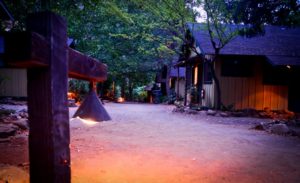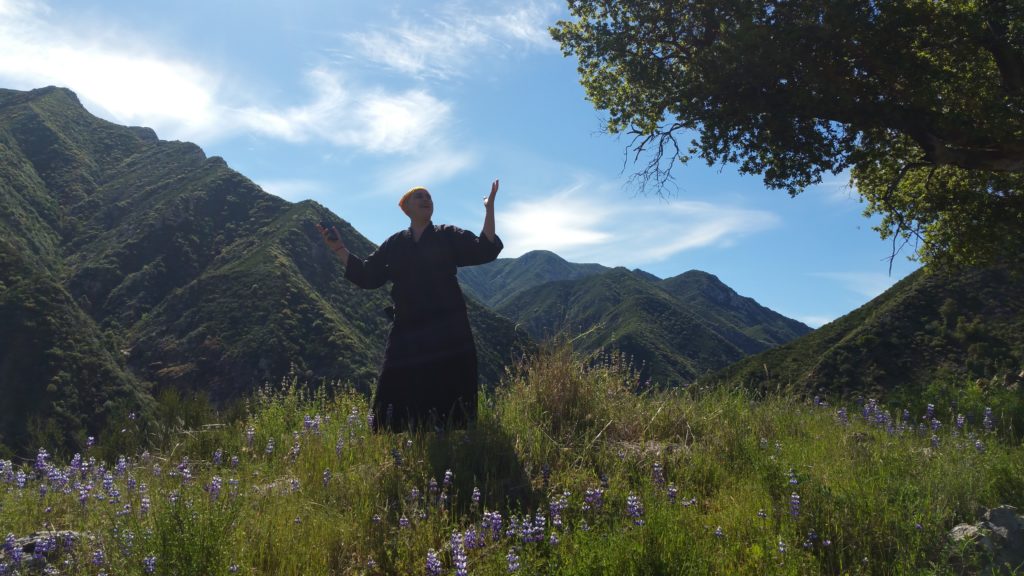 Observations from my first visit to Tassajara
Observations from my first visit to Tassajara
by Louis “Shu” Shuey
1. Getting there is part of the experience.
While not very far from the density of the Bay area, the drive to Tassajara goes by in sequence of stages, each less populated and connected than the last. The final stage, 14 miles of unpaved road and already beyond the reach of cell service, completes a transition into what feels like entirely different time and place. This is a journey best taken with someone who knows the way.
2. The setting supports you.
The monastery is tucked into a thin wrinkle of a valley at the intersection of two creeks and a hot spring. A collection of small buildings and common areas sprinkled along a path that follows the larger creek. For this early-spring visit, the larger creek flowed by in an energizing rush. Trees were lush with new canopy and colorful blooms.
The main buildings are a pleasant mixture stone cottage and Japanese engawa design, arranged to feel like a natural part of the valley. Climb out into the surrounding hills in any direction and most of the facility disappears from view from just a short distance. Gardens and sitting areas are always nearby along the main path, framed by rock walls and borders.
3. The sangha embraces you.

The people at Tassajara during the Spring work period are a mix of staff, teachers, long-tern students and short term visitors. People from all ages, backgrounds and sometimes different countries or continents. Regardless of those differences, all seem to share respect and a sense of care for one another and for the place. Each person welcomes you warmly and smiles or bows warmly as they pass. Sangha members take care of their own needs and also serve each other. While significant attention is given to following proper form in and out of the zendo, kind and gentle guidance is given to those who need it.
The daily routine of work, meals and meditation provides ample opportunity for your preferences to bump up against someone else’s. From the early morning scramble to get coffee or tea in the courtyard, to the myriad decisions that have to be made in small work teams, each day is filled dharma gate moments where frustration has a chance to grab hold of your mind. Before that first spark of impatience can ignite into anything more, you see the face of someone who exchanged bows with you not so long ago or someone who made your breakfast, washed your dishes, or cleaned your favorite bathroom. Everyone contributes to the sense that we are in it together, whatever it happens to be. Respect wins out over selfishness.
 4. Needing something doesn’t mean you lack anything.
4. Needing something doesn’t mean you lack anything. By and large, visitors to Tassajara travel light. Sharing comes naturally and there is no shame in asking for help, a ride, or to borrow something. The staff and volunteers maintain a cache of shareable blankets, clothes and other necessities. Twice a day in work-circle gatherings, sangha members can announce a need or an offer to fill a need. This may sound trivial, but is a profound part of the community fabric at Tassajara.
5. The forms of Soto Zen resonate in a monastery setting.
Austin Zen Center follows the same forms, chants, and signals of any temple in the Soto traditions. The rules and forms for practice, services, the kitchen, were familiar. At the same time, they took on a new sense of meaning or gravitas in the zendo and kitchens of Tassajara. From the ringing of the keisu, the clack of the han, and the thrum of the hokku, to the chants themselves, the ceremony seemed to fit the space.
The routine of the chants and sutras strengthened the sense of community as a shared active practice. Everyone contributes and is part of the team.
The structure of work practice also took on new meaning. There in the mountain monastery, work practice became something much more than everyone pulling their own weight or just lending a hand. There is a deeper giving and receiving at work. Now, on the trip back home, I believe I can bring that new understanding to my own regular practice at AZC.
6. Tassajara is a great place to learn or strengthen a skill. 

From cooking to carpentry, gardening, composting, landscaping, there are great opportunities to get hands-on experience and skilled artisans to learn from.
You are also surrounded by role models for genuine leadership. People who can smile in response to a problem. People who respond thoughtfully, with compassion and often with a sense of humor. The seasoned leaders who have committed to running the operation demonstrate wisdom in action.
7. One week is not quite enough.
One week was just enough time to acclimate to the setting, the routine, the forms – to settle into a relaxed and mindful awareness. Just enough time to make some meaningful connections with other sangha members. Leaving at the end of the week felt just a bit too soon. As we got within range of cell phone coverage, I was not in a hurry to check messages and catch up on news. Finally back in the city, I resolved to get back to Tassajara as soon as “normal” life allows.


Share this:
- Click to email a link to a friend (Opens in new window) Email
- Click to share on Facebook (Opens in new window) Facebook
- Click to share on Telegram (Opens in new window) Telegram
- Click to share on Bluesky (Opens in new window) Bluesky
- Click to share on X (Opens in new window) X
- Click to share on LinkedIn (Opens in new window) LinkedIn
